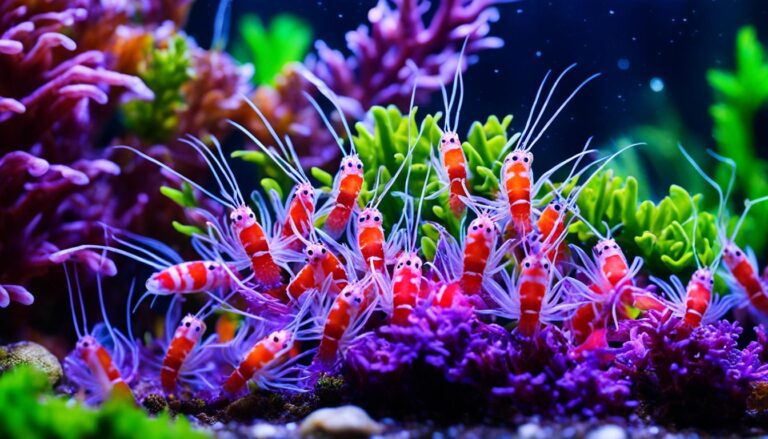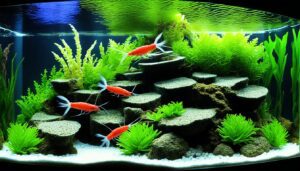Did you know that the stunning Flower Shrimp can live up to two years if you give them the right conditions? Watching these little guys do their silent dance in an aquarium is honestly mesmerizing. So, if you’re into freshwater shrimp care or even thinking about breeding them, here are some tips to get you started.
This guide on Flower Shrimp will spill some cool facts about these fascinating critters. Originating from Southeast Asia, Flower Shrimp, also known as Bamboo Shrimp, can grow up to 3 inches. They’re filter feeders, so they need a spacious tank to mimic their natural environment.
To keep them thriving, aim to recreate their natural river habitats. You’ll need at least a 20-gallon tank, and the water should stay between 71-82°F. Keeping the pH between 6.5 and 7.5 and getting the hardness levels right are super important for Atayopsis moluccensis care. One of the coolest things about these shrimp is their ability to change colors; they come in a range of beautiful hues. Plus, they get along with peaceful fish, adding a chill vibe to any aquarium setup.
For top-notch water conditions, shrimp enthusiasts often go with sponge filters. This setup is also great if you’re considering breeding aquarium shrimp. Breeding takes a bit of patience and finesse, especially when it comes to managing the water temperature.
Warmer water can speed up breeding but may shorten their lifespan, while cooler water does the opposite—slower breeding but longer lives. Keeping tabs on water quality with test kits is key to making sure your shrimp are happy and healthy.
Adding Flower Shrimp to your tank isn’t just about getting a new pet; it’s about crafting a beautiful habitat. They thrive in tanks packed with plants, stones, wood, and moss—providing plenty of hiding spots and natural food sources. From my experience, the real joy of keeping these shrimp comes from paying attention to their environment, their diet, and just enjoying the peaceful presence they bring to your space.
Discovering Flower Shrimp: Behavior & Natural Habitat
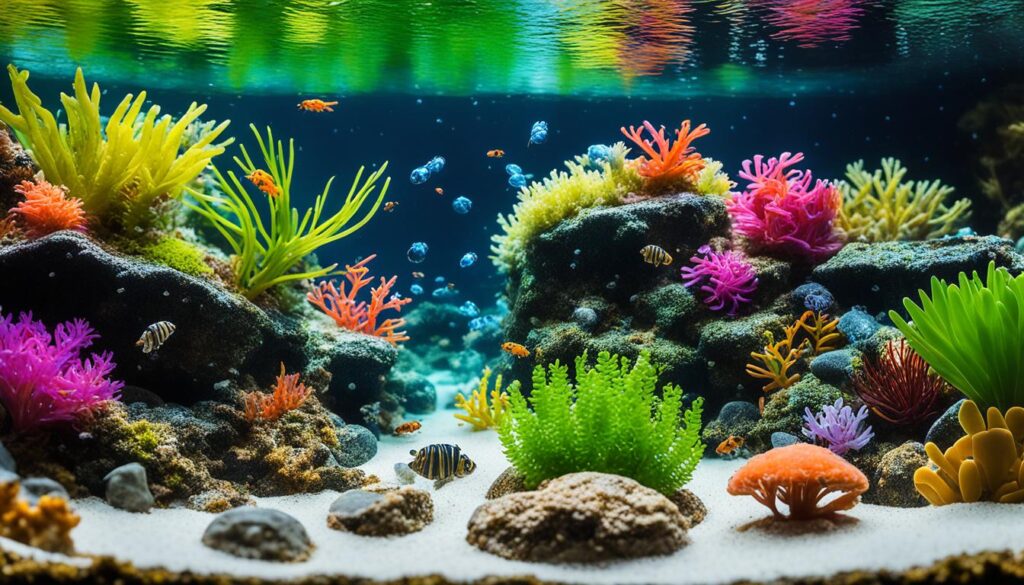
The fascinating world of flower shrimp is full of unique traits and preferences. These creatures are not only a delight to watch but also help keep the aquatic ecosystem balanced.
Dynamic Personalities and Peaceful Coexistence
Flower shrimp are very peaceful in a community aquarium. They are gentle and watchful, living well with other friendly fish and shrimp. Their non-territorial nature allows for easy coexistence.
They are experts in camouflage, blending into their surroundings effortlessly. Depending on their surroundings and mood, they can change color from tan and brown to vivid reds.
Natural Rivers and Streams: The Original Home of the Flower Shrimp
Flower shrimp come from the rivers and streams of Southeast Asia. These waters have fast currents that the shrimp enjoy. In home aquariums, creating strong water flows can mimic their natural habitats.
This setup is vital for their health and activity. It encourages their natural way of feeding, where they sift water currents to find food particles.
Flower shrimps are great for both new and seasoned aquarium lovers. Adding them to your aquarium is not just enjoyable but also promotes a lively and balanced underwater community. Making sure their habitat is similar to their natural one ensures their well-being and lets their true behaviors show, making for an interesting display for all nature enthusiasts.
Creating the Perfect Environment: Tank Requirements for Flower Shrimp
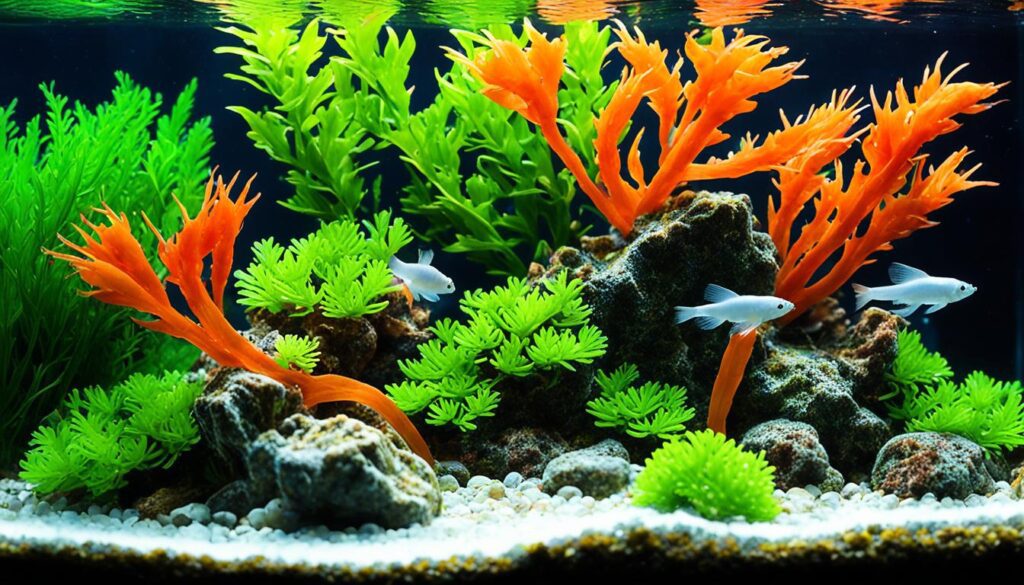
Setting up the perfect environment for your flower shrimp starts with knowing how vital a well-arranged tank is. A strategic setup boosts both the tank’s condition and the shrimp’s wellbeing. This approach helps these sensitive creatures live longer and healthier lives.
Optimal Tank Size and Water Conditions
Choosing the right tank size is your first step. A 20-gallon tank is recommended as it gives flower shrimp plenty of space. Smaller tanks can lead to unstable water conditions, stressing and harming the shrimp.
For a thriving habitat, keep a close eye on temperature and water quality. Flower shrimp do best in temperatures of 65-85 °F but prefer the cooler end. The water should have a stable pH of 6.5 to 8. Regularly test for ammonia, nitrite, nitrate, and pH levels with a trusted liquid test kit.
Landscaping for Flower Shrimp: Plants, Hiding Spots, and Substrate
To echo the flower shrimp’s natural riverbed homes, choose the right substrate, plants, and decorations. Use fine gravel or sand for the substrate to simulate their river environments. This not only looks good but also lets the shrimp exhibit natural habits like foraging.
Plants and hiding places are key for a superior shrimp habitat. Make sure you have a lot of live plants and hideaways. This provides safety and lessens stress for the shrimp. Java Moss and Anubias are great plant choices. They also help maintain water quality by taking in surplus nutrients.
Flowing water is crucial since flower shrimp feed by filtering the water. A moderately flowing tank, achieved with filters or pumps, imitates their natural habitat and supports their feeding. Below is a summary of what you need for a flower shrimp habitat:
Element |
Description |
Importance |
|---|---|---|
Tank Size |
20 gallons or more |
Stability of water parameters |
Water Temperature |
65-85 °F, ideally at the lower end |
Mimics natural cool-water habitat |
pH Level |
6.5 – 8 |
Prevents stress and diseases |
Plants and Hiding Spots |
Ample live plants, rocks, driftwood |
Provides safety and comfort |
Water Flow |
Moderate, clear currents |
Supports natural filter feeding behavior |
Carefully setting up your tank does more than make it look good. It ensures a healthy, sustainable environment for your flower shrimp to thrive in.
The Vibrant Palette of Flower Shrimp: Understanding Their Appearance
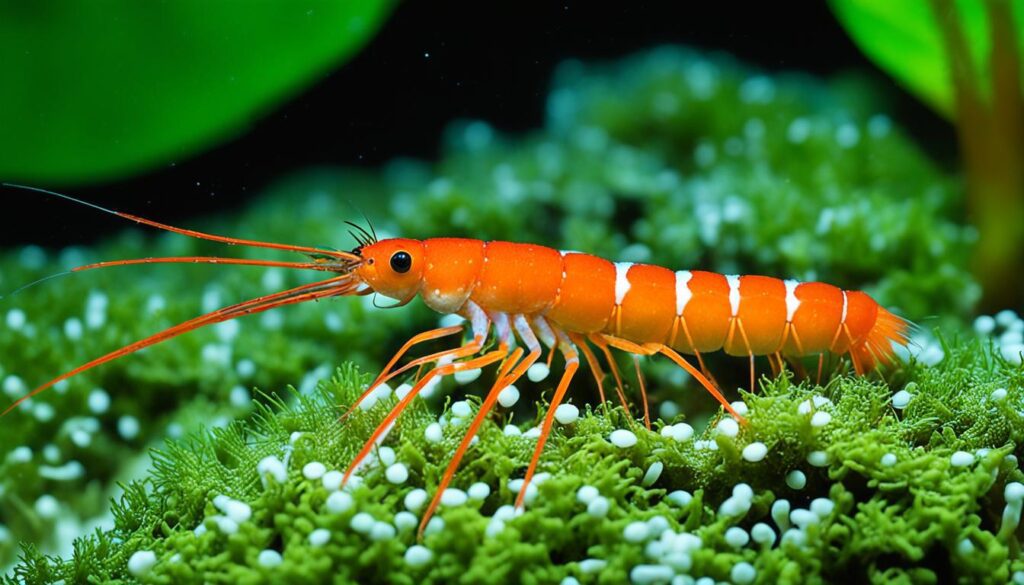
In the water world, the Atyopsis moluccensis or flower shrimp is quite special. Thanks to its vivid flower shrimp coloration, it brightens any home aquarium. Understanding their colors and patterns helps us appreciate these unique creatures more.
The Atyopsis moluccensis has a body that shifts in color. It goes from browns and reds to tans, influenced by their surroundings and what they eat. Young ones have a noticeable stripe on their back, but it fades as they grow. Their shell’s texture is rough, like wood grain, blending into their natural, wood-filled stream habitats.
They also have special fan-like parts for filtering water. These add a delicate touch to their look, making them even more fascinating.
Feature |
Description |
Function |
|---|---|---|
Color Variation |
Ranges from browns, reds, to tans |
Camouflage and mood indication |
Racer Stripe |
Present mostly in younger shrimp |
Could play a role in species identification or mating |
Carapace Texture |
Resembles wood grain |
Enhances camouflage in natural habitat |
Fan-like Appendages |
Four pairs, delicate and feather-like |
Filter feeding mechanism |
Gender Differentiation |
Females are smaller, males have larger forelegs |
Reproductive roles |
Flower shrimp are not only beautiful because of their aquarium shrimp colors. Their behavior and where they like to live make their coloration even more special. Their colors can change with their mood or environment. This helps those who take care of them, making sure they have the best home. The charm of flower shrimp lies in their looks and how they interact with their world.
A Guide to Feeding Flower Shrimp: Diet and Nutrition
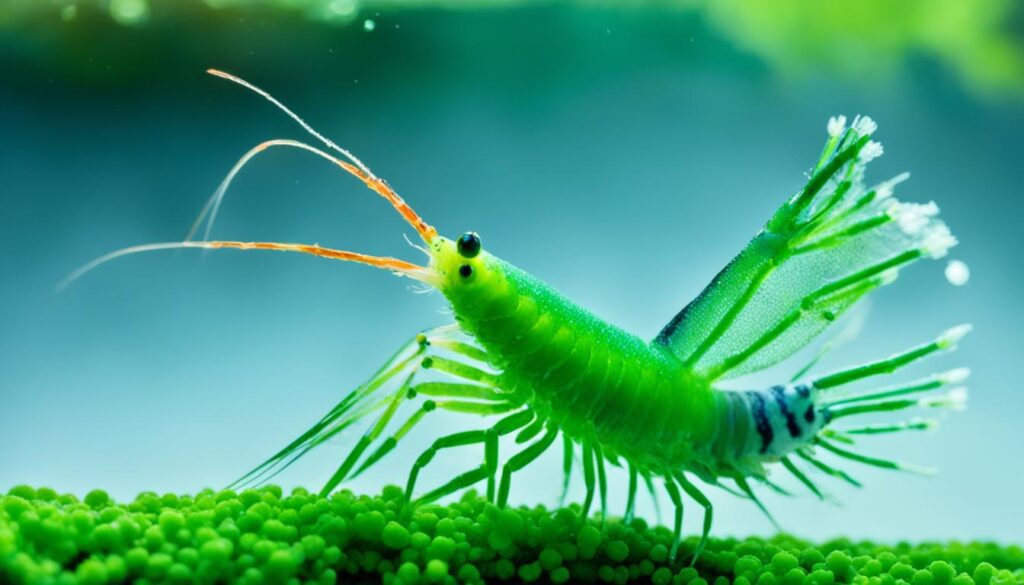
It’s key to know what flower shrimp need to eat. This keeps them healthy and looking bright in your tank. Feeding them right improves their life and your tank’s environment.
Natural vs. Supplemented Diet: What to Feed Your Flower Shrimp
Flower shrimp eat tiny organisms and particles from the water. In a mature tank, they find biofilm, algae, and bits of food. This diet works well for them. But, relying only on this can be risky, especially in new or very clean tanks.
To help them out, add to their diet. Ground-up flake food, algae wafers, and spirulina powder works well. Adding micro worms or pond plankton now and then is a good idea. Make sure the food particles are small enough for their fans.
Feeding Techniques: Ensuring Your Flower Shrimp Stay Healthy and Well-Fed
Feeding shrimp is about what and how you feed them. The way you feed your shrimp is key, especially if you have lots of them or other fish too.
A syringe can help you feed them directly. This stops other fish from taking all the food. Also, set your filter outflow to spread the food evenly in the water. This makes it easier for your shrimp to eat.
Diet Type |
Description |
Benefits |
|---|---|---|
Natural |
Consists of algae, microorganisms, and detritus in the tank. |
Provides essential nutrients, mimics natural habitat. |
Supplemented |
Includes finely ground flake food, algae wafers, spirulina. |
Ensures adequate nutrition, supports health and coloration. |
Changing how and when you feed your flower shrimp helps them a lot. It keeps them healthy and living longer. By mimicking their natural habitat and diet, and making sure they get the right nutrition, your shrimp will do well.
Maintaining a Healthy Colony: Breeding and Care
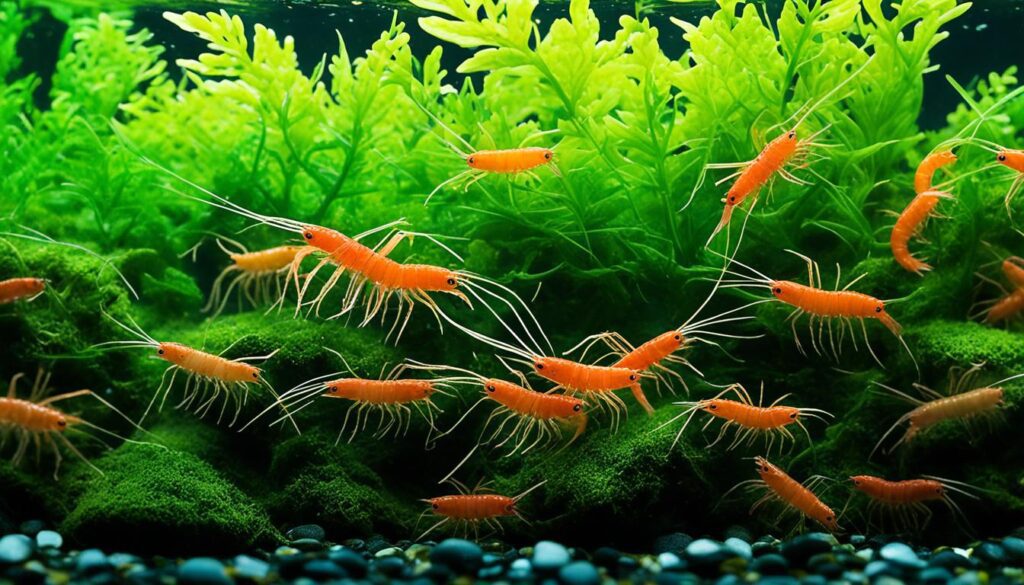
For flower shrimp breeding, mimicking their natural setting is key. Stable water conditions and correct tank population help a shrimp colony thrive. Knowing and caring properly boosts aquarium shrimp reproduction.
To grow a strong colony, knowing how to manage the population is crucial. Aim for 10-15 shrimp per five gallons to give them enough space. Also, a 20-gallon tank is best for breeding. This ensures health and natural breeding.
Keeping the water clean is vital. I change 30% of the water twice a week to maintain purity. For Neocaridina Davidi shrimp, the ideal conditions are 70-76°F, pH 6.8 to 7.5, and GH 4 to 6. Shrimp are sensitive to copper, so watch for it.
Food is key for shrimp health and breeding. They eat biofilm, quality pellets, and sometimes fresh vegetables. This diet meets their needs and supports strong molting and breeding.
Parameter |
Neocaridina Davidi |
Green Jade Shrimp |
Caridina Serrata |
|---|---|---|---|
pH Level |
6.8-7.5 |
5.8-6.8 |
6.0-7.0 |
Temperature (°F) |
70-76 |
68-75 |
64-78 |
General Hardness (GH) |
4-6 |
4-6 |
3-8 |
Proper environment and care raise your chances of successful flower shrimp breeding. Follow these tips for a healthy shrimp colony.
Molting Mysteries: Insights into Flower Shrimp’s Growth Process
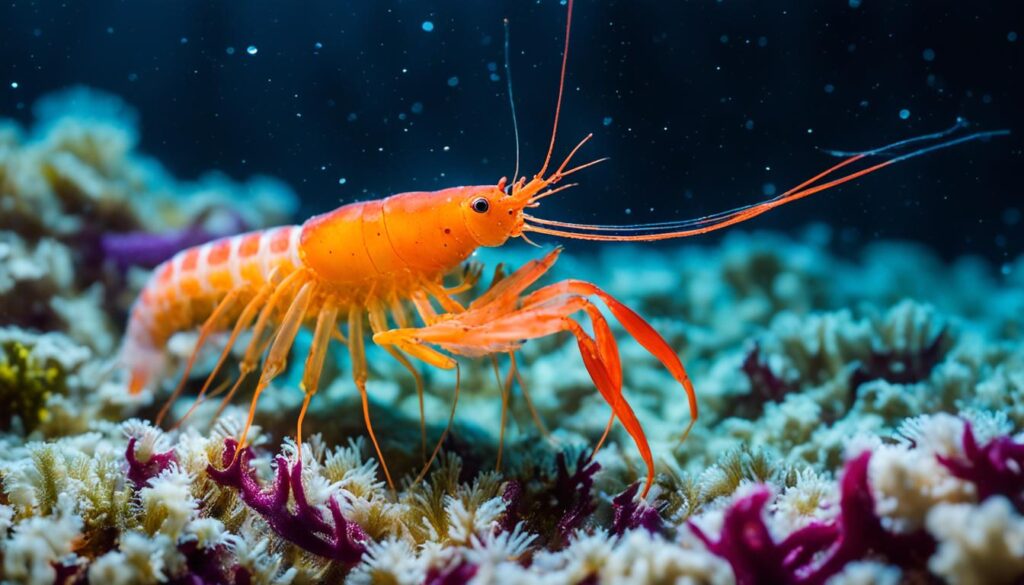
The growth process of shrimp, especially flower shrimp molting, is fascinating. As they grow, flower shrimp must shed their exoskeleton. This is not only about getting bigger; it’s crucial for their health and survival.
Recognizing the Signs of Molting in Flower Shrimp
Noticing when molting starts means watching for subtle changes. Flower shrimp may hide more or become less active as they get ready to molt. Seeing the shed shrimp exoskeleton means molting has happened. Knowing these signs helps you care for them during this important time.
Post-Molt Care: Protecting Your Vulnerable Flower Shrimp
Shrimp are most delicate after molting, with their new shells soft and sensitive. It’s crucial to keep the aquarium safe for them. You should maintain perfect water conditions and offer many hiding places. This helps protect the shrimp from stress or other fish.
- Maintain water pH at 7, with gH at 4, and kH at 3.
- Utilize items like SeaChem Prime to counteract any traces of ammonia.
- Feed sparingly with soft, easy-to-digest foods such as boiled carrots and kale.
The recovery phase is key to helping shrimp get stronger. A calm environment helps their new shell harden. That way, they can get back to normal life safely.
Understanding flower shrimp molting is key for their health. It also makes keeping shrimp more rewarding. Watching them go through this life phase brings a new level of appreciation for their care.
Encountering Challenges with Flower Shrimp: Addressing Common Issues
When we explore aquaristics and flower shrimp care, we often face challenges. These issues can lead to shrimp health problems. Flower shrimp are very sensitive to water quality changes. This includes shifts in pH and temperature levels. Such deviations can cause stress, strange behavior, and in the worst cases, death.
Issues with shrimp tanks also include harmful heavy metals like copper. These metals are toxic to flower shrimp. They might try to escape when their habitat’s quality is poor. Besides, overfeeding our shrimp can pollute the tank. To prevent this, I regularly change the water and adjust the water parameters. This helps maintain a clean tank and meets the shrimp’s dietary needs.
Understanding flower shrimp care challenges requires our attention and quick action. We must monitor our shrimp and act fast when they show signs of distress. Considering aquaponics systems could benefit us due to their efficient space use. With proper care, we can overcome common shrimp farming issues like white spot syndrome virus. By staying alert and proactive, we can ensure a healthy environment for our flower shrimp.
